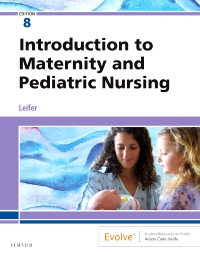
Introduction to Maternity and Pediatric Nursing - Elsevier eBook on VitalSource, 8th Edition
Elsevier eBook on VitalSource

Give your students a solid foundation in maternity and pediatric nursing! Written in a clear, concise, friendly style, Introduction to Maternity and Pediatric Nursing, 8th Edition is the ideal fundamentals teaching and learning text. This best-selling guide is organized by developmental stages, discussions of pediatric disorders by body system from simple-to-complex and health-to-illness, and includes a focus on family health. This edition also contains newly updated NCLEX® style review questions, new unfolding case studies, new content on zika virus, QSEN and safety, and expanded phases of pregnancy.
Newer Edition Available
Introduction to Maternity and Pediatric Nursing - Elsevier eBook on VitalSource
-
- NEW! Discussion of new health threats include in-depth coverage of the Zika virus and Influenza
- NEW! Updated guidelines for hypertension and immunizations for infants and children.
- NEW! Updated QSEN goals and nursing responsibilities reflect the most recent changes.
- NEW! Expanded phases of pregnancy includes preconceptual, prenatal, intrapartum, postpartum and interconceptual care and nursing responsibilities.
- NEW! Updated nursing responsibilities related to global health reflect the "Baby Friendly Hospital" WHO initiative and interprofessional nursing communication related to nursing "hand-off care" and shift change reports.
- NEW! Updated NCLEX® exam-style review questions have been revised with alternate item formats at the end of each chapter.
- NEW! Expanded nursing and safety tips throughout include evidence-based online resources which provide pertinent information applicable in the clinical setting that reinforces what the student has just learned while building on previously learned information.
- NEW! Expanded coverage of bioterrorism better reflects trauma related to pregnancy and pediatric care.
- Evidence-based maternal-child content prepares students for the LVN/LPN to achieve higher levels of learning, a goal expressed by the IOM Committee on the Future of Nursing.
- Over 42 detailed, updated nursing skills introduce students to skills unique to maternity and pediatric care.
- Beginning concepts of critical thinking as a basis for clinical nursing care.
- Over 25 nursing care plans feature seven different formats/themes/styles, including unfolding case studies.
- The beginning concepts of critical thinking introduces students to this idea as a basis for clinical nursing care.
- Updated content on the influence of microbiomes on non-invasive pregnancy and newborn nursing care addresses its impact on the adult health of the newborn.
- Step-by-step application of the nursing process covers the hospital, home, community and use in improving global health.
- Expanded cultural practices as they relate to pregnancy, delivery and pediatric care in the community.
- Coverage of the use of expanding new technologies and computerized medication administration reinforce the nursing process and strengthen problem-solving skills as applied to maternity nursing.
-
- NEW! Discussion of new health threats include in-depth coverage of the Zika virus and Influenza
- NEW! Updated guidelines for hypertension and immunizations for infants and children.
- NEW! Updated QSEN goals and nursing responsibilities reflect the most recent changes.
- NEW! Expanded phases of pregnancy includes preconceptual, prenatal, intrapartum, postpartum and interconceptual care and nursing responsibilities.
- NEW! Updated nursing responsibilities related to global health reflect the "Baby Friendly Hospital" WHO initiative and interprofessional nursing communication related to nursing "hand-off care" and shift change reports.
- NEW! Updated NCLEX® exam-style review questions have been revised with alternate item formats at the end of each chapter.
- NEW! Expanded nursing and safety tips throughout include evidence-based online resources which provide pertinent information applicable in the clinical setting that reinforces what you have just learned while building on previously learned information.
- NEW! Expanded coverage of bioterrorism better reflects trauma related to pregnancy and pediatric care.
-
UNIT I: An Overview of Maternity and Pediatric Nursing 1. The Past, Present, and Future UNIT II: Maternal-Newborn Nursing and Women’s Health 2. Human Reproductive Anatomy and Physiology 3. Fetal Development 4. Prenatal Care and Adaptations to Pregnancy 5. Nursing Care of Women with Complications during Pregnancy 6. Nursing Care of Mother and Infant during Labor and Birth 7. Nursing Management of Pain during Labor and Birth 8. Nursing Care of Women with Complications during Labor and Birth 9. The Family after Birth 10. Nursing Care of Women with Complications Following Birth 11. The Nurse’s Role in Women’s Health Care 12. The Term Newborn 13. Preterm and Post-Term Newborns 14. The Newborn with a Perinatal Injury or Congenital Malformation UNIT III: The Growing Child and Family 15. An Overview of Growth, Development, and Nutrition 16. The Infant 17. The Toddler 18. The Preschool Child 19. The School-Age Child 20. The Adolescent UNIT IV: Adapting Care to the Pediatric Patient 21. The Child’s Experience of Hospitalization 22. Health Care Adaptations for the Child and Family UNIT V: The Child Needing Nursing Care 23. The Child with a Sensory or Neurological Condition 24. The Child with a Musculoskeletal Condition 25. The Child with a Respiratory Disorder 26. The Child with a Cardiovascular Disorder 27. The Child with a Condition of the Blood, Blood-Forming Organs or Lymphatic System 28. The Child with a Gastrointestinal Condition 29. The Child with a Genitourinary Condition 30. The Child with a Skin Condition 31. The Child with a Metabolic Condition 32. Childhood Communicable Diseases, Bioterrorism, Natural Disasters and the Maternal-Child Patient 33. The Child with an Emotional or Behavioral Condition UNIT VI: The Changing Health Care Environment 34. Complementary and Alternative Therapies in Maternity and Pediatric Nursing APPENDIXES Appendix A. Standard Precautions and Transmission-Based Isolation Precautions Appendix B. Sequence for Donning and Removing Personal Protective Equipment (PPE) Appendix C. The Joint Commission’s Lists of Dangerous Abbreviations, Acronyms, and Symbols Appendix D. Commonly Used Abbreviations in Maternity and Pediatric Nursing Appendix E. Common Spanish Phrases for Maternity and Pediatric Nursing Appendix F. Multilingual Glossary of Symptoms Appendix G. Conversion of Pounds and Ounces to Grams for Newborn Weights Appendix H. Normal Vital Signs and Temperature Equivalents of Infants and Children Appendix I. Pediatric Laboratory Reference Appendix J. Blood Pressure Classifications in Children Bibliography and Reader References
Glossary


